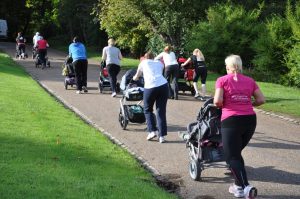Many experts still cannot agree on the definitive answer to this “when a postnatal Mum can or should run” as all human beings are different and all births are different. Mum activity, including running, has grown in popularity in the last 15 years, however most logged research has been based on elite athletes, (Paula Radcliffe and team mates) not a ‘general Mum’ running a slow 100m stretch in a BuggyFit class, or for 30 minutes around a park on a Saturday morning..
If you are keen to get back to running, the key considerations for any postnatal woman are stabilisation and rehabilitation. New Mums need to regain full joint and pelvic stability, realign muscular rebalance, altered biomechanics, and heavy breasts and there could be a change in gait/foot strike. Your precious cargo is something to consider if you wish to run with a buggy too.
Stabilisation:
Hormones occurring naturally in pregnancy bring changes to soft tissue namely, ligaments, cartilage and tendons creating instability. These changes occur in all pregnant women and post birth in breast-feeding Mums. As the process of lactation continues, it stimulates relaxin, the hormone, creating this effect.
The effects of running with joint instability would mean a Mum is more prone to injury. Think of your knee joint. A hinge joint, held together by ligaments, tendons, cartilage. Once these are compromised and slack the joint is left incredibly vulnerable during high impact activity, making the risk of injury a real concern. This translates into other joints that are in need of stabilisation too. Research shows that symptoms will often not show immediately but may take weeks or years to cause effect.
Stability in your pelvis and back:
You have a ‘fan belt’ of stability muscles lengthways around your trunk, which work with your transverse abdominals forming your core. These muscles are compromised during pregnancy and often stretch and weaken to allow the growth of the baby.
Many women suffer discomfort, pain or a general feeling of instability in their pelvis after childbirth. Even after a caesarean delivery, there can be some disturbance around the pelvis due to the weight of the growing baby or babies. Another concern is organ prolapse, often described as feeling like “something is falling out”, or “just doesn’t feel right”. This is where the pelvic floor muscles are struggling to do their job of holding the organs in place.
Pelvic floor recovery:
High impact workouts, heavy lifting and sit-ups or crunches. These are all completely inappropriate for women with dysfunctional pelvic floor muscles as the load bearing down will compromise it‘s strength and further weaken the muscles and soft tissues leading to a risk of prolapse. If your exercise makes your pelvic floor feel less stable or you experience leaking then this is a sign to stop and find alternative exercises. There are plenty out there. It does not mean easier, simply working out smarter. Rehabilitation is key. Small goals worked at consistently will bring trustable strength under the correct professional guidance.
There is no guarantee that a ‘runner’ will find it comfortable or easy to get back into running, and often once Mums try to run they realise the discomfort out ways any gain they may get.
Altered breast ligaments, increased size and weight, discomfort and possible leakage may be enough to change your thoughts on running too soon. Research shows that stress fractures can be caused by the low levels of oestrogen as a result of lactation. Lactation also produces relaxin, the hormone creating joint elasticity and joint vulnerability. Reducing the quantity of breast feeds lowers the levels of relaxin, meaning a structured return to more high impact exercises (assuming strength and stability has returned in the joints pelvic floor and abdominals), may begin.
However- think of your recovery post birth as building your dream home. You would not start laying the bricks without first building down into the ground to create foundations. Whilst these are soon invisible and often take investment, they will ensure your home stand s strong for many years to come!
So when is it ok to start running?
We suggest 6-months minimum, but each postnatal Mum is different and her journey may be a factor in whether this is still too soon.
High impact or heavy lifting exercises are deemed inappropriate with any signs of a dysfunctional pelvic floor, diastasis recti (tummy gap) or general feeling of instability. Exercises that increase the load on the pelvic floor, such as running, contact sports, high impact training where both feet leave the floor even for a split second, or heavy lifting, are likely to create a weaker ‘foundation’ rather than strengthen it. Women, especially those whom have experienced a caesarean section birth will also need to rehabilitate the strength in her abdominal muscles to ensure her core is able to cope with the increase in load and impact.
What to do now-
We would encourage all mums wishing to return to running to get a health check with a women’s health physiotherapist, or specialist fitness professional, who will check your abdominal gap and will assess your pelvic floor function.
Check your running shoes fit well and support still. These may need to be reassessed as often the need for a larger shoe size arises from slightly dropped arches in pregnancy and post birth often remaining for life.
Once you feel strong with no physiological concerns we recommend phasing in your return to a running programme, keeping distances short, pace slow and decent recovery periods between. The cliché Listen to your body and respect it is paramount with your return to running.
Protect your breast tissue by wearing a well-fitting sports bra.
Remember to rehydrate and refuel post run.
The pelvic floor and abdominal muscles must be fully rehabilitated to avoid unnecessary stress to the areas during high impact exercise. Running could cause further irreversible damage so be mindful of your body during and after your run, seeking medical advice if you are unsure.
What about running with the buggy?
There are few buggies that state on the manufacturing label that they are promoted to run with, however if you look hard enough some claim you may run with them in their text.
None of these will promote running with a baby in your buggy until baby is at least 6 months, 9 months with many others.
There are two elements of concern. Mother’s health and physical stability and baby’s neck strength and safety !
There are potential issues for the baby and the safety in the buggy or pram to bear in mind – ALL babies must be strapped in. Please be aware that some buggies for young babies to lay flat do not have safety harnesses. We strongly encourage you not to run until your baby is old enough to be in a ‘strapped in’ position.
In summary
Ensure you are aware of all risks, always start with a walking programme to gain strength or better still a structured postnatal programme at a class, such as Buggyfit® run by a specialist trainer. Make sure you have been physically checked, are wearing appropriate clothing (sports bra, suitable running shoes) and experience none of the issues discussed here before commencing your running programme.
Listen to your body, if it does not feel right then…it probably is not and may be causing more harm than good.
Written by Emma at Buggyfit HQ



